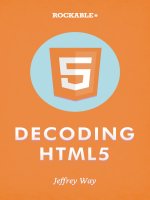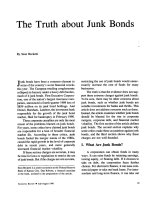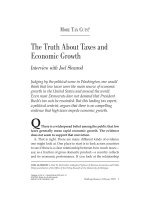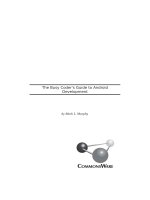createspace publishing the truth about html5 (2012)
Bạn đang xem bản rút gọn của tài liệu. Xem và tải ngay bản đầy đủ của tài liệu tại đây (4.74 MB, 269 trang )
The Truth About HTML5 (For Web Designers)
Copyright © 2012 Luke Stevens
All rights reserved
Written and designed by
Luke Stevens
Edited by
Bill Harper
(Portions of this book have been updated post-edit, so any mistakes are entirely those of the author!)
Published by
Indie Digital Pty Ltd
Spotted an error or typo? Let me know:
Thanks for reading!
Luke
TABLE OF CONTENTS
CHAPTER 1
A Somewhat Sensationlized History Of HTML5 1
CHAPTER 2
A Basic HTML5 Web Page 21
CHAPTER 3
Structuring A HTML5 Page 27
CHAPTER 4
HTML5's Structural Elements 49
CHAPTER 5
HTML5 Micro-Semantics And Schema.org 75
CHAPTER 6
HTML5 And SEO 95
CHAPTER 7
HTML5's Other New Elements 99
CHAPTER 8
HTML5 Forms 109
CHAPTER 9
HTML5's Canvas, Gaming And Flash 133
CHAPTER 10
Audio & Video In HTML5 185
CHAPTER 11
SVG: The Flash Challenger That Was, Wasn't, & Now 213
CHAPTER 12
HTML5 Web Apps, Mobile & What Comes Next 235
CHAPTER 13
The Future Of Web Design: Performance Based Design 255
FOREWORD
HTML5 is a mess. It's also one of the most exciting technological
advances perhaps ever (a big claim, especially for something I just
described as a mess).
There are quite a few books, most of them excellent, on HTML5.
Some cover the markup exclusively. Some cover markup and
JavaScript APIs. Others still focus on a specific development
challenge like games.
This book is a little different. Rather than simply looking at the what
and how of HTML5 (though it does that as well) it endeavors to
explain the why and why not of HTML5.
And it's a passionate, informed, opinionated critique of much of
HTML5 to boot.
Along the way you'll learn a great deal about HTML5 markup, and
additional HTML5 features such as the new audio and video elements,
the Canvas element, the History API, and related features such as
SVG.
But hopefully most of all you'll learn to think critically about HTML5
as a tool, and adopt the good parts, for good reasons, and ignore the
less than useful parts, for the right reasons as well.
Luke Stevens has written a book all web designers and developers
who care about their code should read. So go ahead and read it!
John Allsopp
Author, Developing with Web Standards
Co-founder of Web Directions
Web evangelist
INTRODUCTION
Hi. I’m Luke, your average, garden-variety web designer. I’ve been
building web sites for over a decade, use ExpressionEngine as my
CMS, and have enjoyed both working in-house and full-time
freelancing.
I thought it would be fun to write a short book about HTML5. I
thought HTML5 would be simple. I thought writing about it would be
straightforward. And I thought the respected voices in the design
community would be telling everyone what it is (and what it isn’t)
simply and clearly, particularly with the plethora of other HTML5
books out there.
I was wrong.
Fortunately this book (and hopefully your experience as a reader!) is
infinitely better for it. And I hope once you’ve read it you’ll share my
concern about the strange direction basic markup has taken, and my
excitement for the new HTML5 (and related) technologies that are
coming soon to a browser near you. That includes Internet Explorer
10—Microsoft finally, truly gets web standards.
What seemed impossible just a few years ago—a far-fetched, almost
utopian ideal of all browser vendors, including Microsoft, competing
tooth-and-nail to support bleeding-edge web standards—is now a
reality. Innovation in web standards is happening at a break-neck
speed, and my hope is this book gets you up to speed not only with the
fundamentals of HTML5, but with the broader picture of where the
web as a whole is heading, especially as we look towards a post-Flash
future.
As you make your way through the following chapters, please keep in
mind this book is as much of a critique as it is an explanation of
HTML5. By taking a critical look at why things are the way they are,
my hope is you save hours by not having to worry about things that
don’t matter (particularly when it comes to basic markup), and your
eyes are opened to how the HTML5 sausage gets made. It may not
always be pretty, but if you spend your days in the trenches building
websites, knowing why things are the way they are will help guide
your design and development decisions in a very direct way.
That said, there’s plenty of exciting technology in and around HTML5
too, so be sure not to miss the later chapters on graphics technologies
like Canvas and SVG; the state of audio and video in HTML5; and the
more developer-oriented HTML5 features that includes a new way of
handling something as fundamental as a page request.
(Also note we will be focusing almost entirely on HTML5 as defined
by the HTML5 spec, with the addition of SVG, and a few other related
initiatives such as Schema.org and WebGL. “HTML5” has become a
buzzword which can mean everything from the HTML5 spec itself, to
CSS3 and modern JavaScript, to just “cool and new and not Flash”.
We’ll be mostly sticking with the features in the actual HTML5
specification.)
I love the web design community because it’s filled with smart,
excitable, curious, opinionated folk who will call you on your BS.
This is an opinionated book, not a dry explanation of the technology,
and I’ll be stating my views pretty strongly. I look forward to you
doing the same. Passionate, considered debate makes us all smarter.
So please, write it up on your blog, send me happy/sad/angry emails
(), talk to me on Twitter (@lukestevens), or whatever
you like.
I look forward to the discussion.
And now I’d like to ask a couple of favors.
First, if you enjoy my writing then please tell your friends, colleagues,
Twitter followers, blog readers, and pretty much anyone who will
listen about this book. Like a lot of authors, I rely entirely on readers
like you to spread the word (and the links). If you can help me out by
spreading the word about this book via good old fashioned word of
mouth I’d really appreciate it. Thank you.
And second, if you use Google Analytics (and who doesn’t?) and want
to get more out of it, I’d love you to check out my web app Ninja for
Google Analytics at . Google Analytics is a big,
complex beast, but it has the best data on how your web site actually
performs, it’s just buried deep, deep down. Ninja for GA brings that
data to the surface through a simple, elegant interface. It’s web
analytics for web designers, and I think you (and your clients) will like
it. My hope is it will make your own design practice (and your client’s
sites) more productive and profitable. After all, all the HTML5 in the
world wont help you if your conversion rates are lousy and your
bounce rates are sky-high. (We’ll return to this theme in the final
chapter of this book when we look at Performance Based Design.)
Check it out: .
CHAPTER 11
A SOMEWHAT
SENSATIONLIZED
HISTORY OF HTML5
How Architecture Astronauts And The W3C Tried To Kill
HTML
Murder is always interesting, so let’s start there.
In 1997 the W3C published a Recommendation for HTML 4.0. And two years
later it was more or less completed in the form of HTML 4.01. (Don’t
remember? Well, you were probably too busy worrying about the dreaded Y2K
“bug” wiping out civilization.)
And that was pretty much it for plain old HTML.
So what happened between HTML being “finished” in 1999 (in every sense of
the word), and HTML5’s emergence today?
A long, aborted march to “XMListan”.
The W3C published the eXtensible Markup Language (XML) 1.0 spec in 1996
( which they hoped would become
a more flexible, machine readable, stricter and more extensible way to mark up
documents and other data. And it was soon being used to do just that. But the
W3C believed the web itself would eventually move to XML.
One of the first baby steps in that direction was XHTML—an XML formulation
of HTML 4.
1
You Probably Use XML
XML may sound foreign, but if you own or even subscribe to a blog then you’re
already using it. The RSS or Atom feed blogs generate to syndicate their content
is just one form of XML. If you look at the source of an Atom feed, you can see
tags such as <author>, <published>, <category> and <summary>. These
are specific tags that accurately describe the content they represent. It’s just one
example of the “extensible” part of XML that allows machines (parsers, RSS
readers and so on) to do interesting things with the content.
Now, imagine a world where we could describe our web pages in a similar way.
That was the W3C’s plan for the web—that all the future content on the web
should be described in more accurate terms than just <div>s, <span>s, <p>s
and <h1>s. And with XML, we could do it.
HTML would still exist as a legacy format. But the future was XML, baby.
XHTML Is Born, But What Does It Mean?
So if HTML was the past, and XML was the future, how would we get there?
With the interim step of XHTML.
By reformulating HTML 4.0 to stick to XML’s rules, XHTML was born. And in
January 2000, having barely survived the Y2K apocalypse, the XHTML 1.0 spec
was adopted as a W3C Recommendation ( We
were on the road to XMListan.
In early 2002, Jeffrey Zeldman published the landmark XHTML article “Better
Living Through XHTML” on A List Apart ( />betterliving/), describing XHTML as:
[T]he standard markup language for web documents and the successor
to HTML 4. A mixture of classic (HTML) and cutting–edge (XML), this
hybrid language looks and works much like HTML but is based on
XML, the web’s “super” markup language, and brings web pages
A SOMEWHAT SENSATIONLIZED HISTORY OF HTML5
2
many of XML’s benefits, as enumerated by the Online Style Guide of
the Branch Libraries of The New York Public Library.
Those benefits enumerated on the The New York Public Library website
( included:
The web is moving to XML, a powerfully enabling technology. Writing
well–formed, valid XHTML pages is the easiest way to begin this
transition. All it takes is learning a few simple rules of XHTML
markup.
Web designers took heed of this call to begin the transition to XML via
XHTML. In 2003 Dave Shea wrote a post called “Semantics and Bad Code”
( where he said:
The move from HTML to XML requires a huge shift in developer
mindset. There are a lot of obstacles to overcome yet, not the least of
which being solid browser support. We’ve only started down the road,
and XHTML is how we’ll get there.
Shea’s view was a popular one at the time, and certainly reasonable given our
faith in the experts in the W3C.
But we never made it to XMListan. The car ran out of gas, the wheels fell off,
and the engine exploded about two blocks down the road.
Draconian Error Handling, Or Why Don’t I Just Punch You
In The Face?
Those of you building web sites back in the early ‘00s may remember how
important it was to have a valid web page. People even put dinky little “Valid
XHTML” badges on their sites to show off just how forward-thinking they were.
(They now put equally silly HTML5 badges on blogs—and books.) Design nerds
would even run other people’s markup through the HTML validator, and write a
snarky blog post or email if it failed. (Back then there was no Twitter to bitch
publicly in 140 characters.)
THE TRUTH ABOUT HTML5
3
Yes, having valid HTML is a good thing. But as web designers adopted XHTML
it became—in theory, if not practice—life or death. If you had so much as single
error in your XHTML, your browser would reach out and punch you in the face.
Okay, Not Really. But We COULD Punch You In The Face
Well, it would if you set up your server to tell the browser to adopt XML’s strict
XHTML parsing rules (as Mark Pilgrim described in 2003: />pub/a/2003/03/19/dive-into-xml.html), which hardly anyone did. Internet Explorer,
right up to and including version 8, didn’t even support these strict XHTML
parsing rules. (Ironically, IE9 now does, just as everyone stopped caring.)
Why didn’t anyone do it? Because they didn’t want to inflict the “draconian
error handling” on their users (or themselves). And it really was draconian—one
invalid character, such as “&” instead of “&”, would generate a fatal error
that destroyed the entire page. And as a user, all you got was a hideous error
message—no content, no nothing.
In light of this, the web standards community adopted the theory of XHTML
without its harsh realities (or true XML nature), preferring to stick with the
warm, cuddly and vastly forgiving HTML parsing from the early days.
XHTML turned out to be a baby step towards a baby step. What should have
been the first move towards a strict XML formulation of the web, where we
could use more descriptive (i.e. semantic) tags, was just a step towards stricter,
old-style HTML. It was two steps forwards, one step back—back to the HTML
the W3C had declared finished, and was hoping to make obsolete.
XHTML Still Meant Better HTML
Nevertheless, XHTML gave the web standards community something to, well,
standardize on. It allowed everyone to be a bit more serious, and dare I say
professional, about the markup we were writing. As Jeffrey Zeldman wrote on
his blog in 2009 ( />A SOMEWHAT SENSATIONLIZED HISTORY OF HTML5
4
XHTML’s introduction in 2000, and its emphasis on rules of
construction, gave web standards evangelists like me a platform on
which to hook a program of semantic markup replacing the bloated
and unsustainable tag soup of the day. The web is better for this and
always will be, and there is much still to do, as many people who
create websites still have not heard the call.
For much of the ‘00s, websites built with web standards continued using
XHTML. Designers got serious about separating presentation from content, and
tried to write more semantic markup. Using XHTML also triggered standards
mode on the major browsers of the time. All good things.
But in the W3C’s grander scheme of things, XHTML ultimately proved to be a
bit of a stepping stone to nowhere.
But The Crazy Had Only Just Begun
XHTML served a useful purpose for web standards—albeit not the one
originally intended. But now we step into the mad, mad, mad world of XHTML
2.0.
While we were all happily using and advocating XHTML in web standards land
(though some stuck to HTML 4.0), the W3C was working on XHTML 2.0.
Sounds like a harmless update of the 1.0 spec, right?
It wasn’t.
XHTML 2.0 was day zero for the web. It wasn’t backward compatible with
HTML, or even XHTML 1.0. It was a whole new thang.
And nothing was safe.
Among the list of sweeping changes, plain old forms would be replaced with
fancy XML-style XForms. Even the <img> element was on the chopping block
at one point, as the W3C re-envisioned the web as a more XML-ified place.
THE TRUTH ABOUT HTML5
5
In an April 2011 blog post on software development, Joel Spolsky described
what he calls “Architecture Astronauts” ( />fog0000000018.html):
When you go too far up, abstraction-wise, you run out of oxygen.
Sometimes smart thinkers just don't know when to stop, and they create
these absurd, all-encompassing, high-level pictures of the universe that
are all good and fine, but don't actually mean anything at all.
These are the people I call Architecture Astronauts.
And XHTML 2.0 was a classic case of Architecture Astronauts at work.
Here’s how Bruce Lawson, HTML5 evangelist for Opera and author of
“Introducing HTML5” (New Riders, 2010) describes it ( />8301-17939_109-10281477-2.html):
XHTML 2 was a beautiful specification of philosophical purity that
had absolutely no resemblance to the real world.
As far as HTML was concerned, this is what the W3C—the custodians of the
language that underpins much of our relationships, business, and government in
the 21st century—worked on from 2002-2006 over 8 drafts. Not only would it
have broken backwards compatibility, it would also have sent all the talk of
“forward compatibility” and “future-proofing” in the web standards community
up in smoke. (You can read more about XHTML 2.0 in Wikipedia:
/>XHTML 2.0: Unloved And Alone
While the W3C toiled away on XHTML 2.0, what did web authors, standards
advocates, and browser vendors think of it?
Not much.
A SOMEWHAT SENSATIONLIZED HISTORY OF HTML5
6
There was zero interest in implementing it. Even members of the working group
were deeply unhappy with it. (See Jeffrey Zeldman’s thoughts on XHTML 2.0 in
2003 under “XHTML 2 and all that”: />What was dopey about XHTML 2.0 wasn’t so much the spec itself (which would
be fine if we could go back in time and rebuild the web from scratch). It was the
idea you could do something as revolutionary as breaking backwards
compatibility with millions of existing documents and create a whole new tier
for the web. But that was the path the W3C set themselves on way back in 1998
(see it for yourself in "Shaping the Future of HTML"” />future/).
But what if the next evolution of HTML was just that—evolutionary, rather than
revolutionary? One that built on the world as it was, and not some utopian world
we could only hope for?
HTML5: A New Hope We Hope
HTML5 began as a reaction to the W3C’s descent into markup madness. The
problems with the W3C’s direction had not gone unnoticed.
In 2004, the so-called “Web 2.0” movement took off in a big way, and web
applications became a big deal. The web was no longer just a collection of text
and images on pages connected through links. It was becoming a platform for
applications that could run anywhere, OS be damned.
Compared to the ‘80s and ‘90s, when your OS determined what applications you
could use, running applications through a browser on any OS was a
revolutionary idea.
No one really predicted this (certainly not the W3C), which isn’t surprising when
you think how bad we are at predicting the future in general. (Where is my
flying car?) We’re much better at reacting and evolving when the future arrives,
which is what some people suggested we do with HTML.
In 2004, members representing Opera and Mozilla (with Apple “cheering [from]
the sidelines”, as Ian Hickson recalls: />THE TRUTH ABOUT HTML5
7
interview-with-ian-hickson-editor-of-the-html-5-specification/) presented an
alternative to the W3C—a spec focused on web applications. (See the original
“Position Paper” here: />opera.html.)
The W3C Says Go To Hell
HTML needed to adapt to the future of web applications, rather than a utopian
world of perfectly marked-up XML-ified web pages. So this new group
suggested an alternative direction for HTML based on backwards compatibility.
No more draconian error handling (the one-error-and-you’re-dead problem of
XHTML as XML). New features for web applications. And an open process,
which was in stark contrast to the way the W3C operates.
Essentially, their philosophy was that HTML was here to stay, and so we should
concentrate on evolving it. (This may sound completely obvious now, but back
then it wasn’t a view shared by the W3C.)
Anyway, the group pitched their ideas to the W3C, and the W3C told them to go
to hell. (Actually, they only lost by two votes—11-8 against. But this is the
somewhat sensationalized history of HTML5.)
With the W3C being less than accommodating, those interested in evolving
HTML and adding features for web applications, and who were backed by (and
worked for) the browser vendors, decided to press on and work outside the W3C.
They formed the Web Hypertext Applications Technology Working Group
(WHATWG), and set up shop at whatwg.org in June 2004.
The WHATWG Is Born
And so the WHATWG was born. Here’s how Hickson explains it all
( />So [after the W3C rejection] we opened a mailing list called the
WHATWG to continue work on Web Forms 2.0 in public, and later
that year started a new draft called Web Applications 1.0 into which
A SOMEWHAT SENSATIONLIZED HISTORY OF HTML5
8
we put many features aimed at writing Web apps, including a new
version of HTML that we jokingly called HTML5, and a bunch of other
features that later became Web Storage, Web Sockets, Server-Sent
Events, and a variety of other specs. [ ]
Later, around 2006 or 2007, the W3C basically realized they had
made a mistake, and they asked if they could work on HTML5 as well,
so we renamed Web Applications 1.0 to HTML5, and the WHATWG
and the W3C started working together. Web Forms 2.0 got merged
into HTML5, and most of the bits of HTML5 that weren’t really HTML
got split out into separate specs.
It’s ironic, isn’t it? The establishment (the W3C) was the utopian revolutionary,
and the rebel outsiders (the WHATWG) were fighting for incremental
conservatism. Go figure.
It’s A Whole New World
It’s worth noting several points here:
• The W3C failed dramatically at maintaining HTML (which is kind of
scary when you think about it).
• Web standards are incredibly haphazard. There was—and is—no unifying
vision of “HTML5”. It was just a bunch of separate specifications bundled
up and given the name “HTML5”, and those specifications only came
about as a reaction to the W3C’s failures.
• Big, bold ideas like the march to XML for the web—which had many
people excited a decade ago—can fade to nothing. We should learn from
this, and retain some skepticism towards big, bold ideas—including some
of the changes in HTML5.
• The balance of power now rests with the browser vendors.
In truth, the balance of power has always rested with the browser vendors. If
they don’t implement something, by definition it’s a non-starter. As Hickson says
( />html-5-specification/):
THE TRUTH ABOUT HTML5
9
The reality is that the browser vendors have the ultimate veto on
everything in the spec, since if they don’t implement it, the spec is
nothing but a work of fiction. So they have a lot of influence—I don’t
want to be writing fiction, I want to be writing a spec that documents
the actual behavior of browsers.
Whether that’s too much, I don’t know. Does gravity have too much
influence on objects on earth? It’s just the way it is.
Nevertheless, the fact an independent standards body—our independent
standards body—failed miserably is more than a little concerning.
To HTML5 And Beyond!
To cut a long story short, the WHATWG kept working on their own vision of
evolving HTML—the only vision of evolving HTML. And in 2006 Tim Berners-
Lee, father of the World Wide Web and Director of the W3C (read more about
him here: sucked it up and
announced the W3C would work with the WHATWG, saying
( />The attempt to get the world to switch to XML, including quotes
around attribute values and slashes in empty tags and namespaces all
at once didn't work.
Berners-Lee left the door open to switching to XML by saying “all at once”. But
in reality it looks very much like “The attempt to get the world to switch to
XML didn’t work.”
And that’s fine. We need big ideas and bold directions to try and work towards,
and if they don’t work out, so be it. Sometimes good ideas just don’t happen.
With the WHATWG having so much momentum (and the backing of the
browser vendors), the W3C had no choice but to work with them on HTML5. In
2007 the W3C formed a group that worked work with the WHATWG on
developing HTML5. And in January 2008 the W3C released their first HTML5
A SOMEWHAT SENSATIONLIZED HISTORY OF HTML5
10
Working Draft ( adopting the
work the WHATWG had been doing for several years.
HTML5 Is The New Black Or Hotness Or Something
By the late ‘00s web technologies were exciting again, and after years of
stagnation and dead ends we finally reached a point where the bowels of
innovation were loosened. (That’s a horrible image—sorry.)
Now in the early ‘10s, things are looking even better. In fact, there’s a veritable
Cambrian explosion of web technology taking place. Google, Mozilla, Apple
and Microsoft are competing to make the best standards compliant browser
(with new versions coming thick and fast). There’s a whole bunch of new and
interesting technology around. And web developers, designers, software
companies and app developers are all interested in the new and shiny tech in and
around HTML5.
To think browser makers—including Microsoft—are now trying to outcompete
and even out-market each other with their web standards support is pretty
incredible. It wasn’t that long ago (late ‘90s) that we faced the threat of them all
going their own non-standard ways. Hats off to all involved.
Is HTML5 Hype, Substance, Or Both?
But back to the HTML5 specification. Two questions:
1. What exactly is HTML5?
2. Who’s in charge, now there’s a (decidedly uneasy) working relationship
between The Establishment (the W3C) and The Rebels (the WHATWG)?
Let’s deal with what HTML5 is first. There’s:
• HTML5, the all-encompassing marketing buzzword
• HTML5, the bit that’s actually about HyperText Markup
• HTML5, the new functionality available through JavaScript for web
applications
THE TRUTH ABOUT HTML5
11
• HTML5, the behind the scenes stuff that’s really important and documents
a whole lot of stuff browsers actually do (but you’re probably not
interested in).
All this from a technical specification that runs for hundreds of pages.
For us web designers, HTML5 is currently a confusing mix of hype and
substance, which we’ll try to sort through in the coming chapters.
In many ways HTML5 is, to put it bluntly, a mess. But it’s the most ordered
mess we’ve had in a long time. (For instance, a big part of HTML5 is written for
browser vendors to ensure implementations are consistent and we can trust all
browsers to do the same thing. And that’s never been done before.)
Perhaps the biggest problem is everyone thinking that if HTML5 is cool, then all
of it (at least according to the web design community) must be great, and we
should adopt it post-haste without too much critical thought. And that’s
something I’m keen to dispel in the rest of the book.
Hixie Or Bust
As I write this, both the WHATWG and W3C versions of the HTML5 spec (the
differences between the two are minor) are edited by one person: Ian Hickson.
HTML is now essentially in the hands of one man.
The W3C’s working groups tried building consensus, and got absolutely
nowhere with HTML. It was closed, but democratic. The WHATWG, on the
other hand, has an open process, but with an editor-has-the-final-say approach.
And that editor is Ian “Hixie” Hickson.
Hickson helped start the WHATWG when working for Opera, and now works
full-time for Google developing the HTML5 spec. Currently, he is the HTML5
(and now just “HTML”) editor for life. Theoretically, the browser makers can
veto him or kick him out at any time, but that seems highly unlikely. This has
not gone unnoticed in the community, and is (rightly, in my opinion) a cause of
some concern.
A SOMEWHAT SENSATIONLIZED HISTORY OF HTML5
12
It’s a classic “glass half-full/glass half-empty” situation. If Hickson flat out
refuses an idea (which is known to happen), then having a single person in
charge may seem like utter madness. But for those who saw the W3C’s
democratic processes get nowhere with XHTML 2.0, having someone who can
take the reins, push things along, and actually make decisions would seem
wonderful.
Of course, this invariably polarizes people.
Here’s John Gruber of Daring Fireball fame ( />01/hickson-codecs):
Let it be said that Ian Hickson is the Solomon of web standards; his
summary of the situation is mind-bogglingly even-handed and fair-
minded.
And here’s Kyle Weems, creator of the CSSquirrel comic, who has been
following HTML5’s development for several years ( />status/58559284224589824):
Also why oh why is @hixie still the editor for any world-altering
spec like HTML anymore? Ego doesn't even begin to describe his
antics
As you can see, Hickson has his fans and his detractors.
I imagine editing a spec the size of HTML5 for as long as he has, with all the
controversy that surrounds it, would be a pretty thankless task. But Hickson
seems to go about it in a cheerful, dispassionate way.
If there’s one overarching theme here, it’s this: pragmatism rules.
The W3C had the “pure” spec of XHTML 2.0, and failed—it wasn’t pragmatic.
It also had its rules, membership, and democratic processes, but was mired in
politics and failed (with HTML at least)—it wasn’t pragmatic.
The WHATWG put an editor in charge, and while this approach terrified and/or
infuriated some people (including me from time to time, as you’ll soon see), it
THE TRUTH ABOUT HTML5
13
was pragmatic (as was their approach to the spec). It got things moving (and,
more importantly, shipping). And as long as it remains pragmatic it’s probably
how the WHATWG will stay.
XHTML 2.0 Is Dead And Everyone Is Happy
So what happened to XHTML 2.0? It was pronounced dead after being taken off
life support in 2009 ( I hear the death of
XHTML 2.0 will soon be fictionalized in an upcoming episode of “Law &
Order: Web Standards Unit”.
And what about XHTML 1.0 and its various flavors? Considering it’s essentially
just HTML, it will keep working pretty much forever. (There’s actually a
continuing XML serialization of HTML5 called XHTML5, but the chance of
you actually needing to use it is practically zero.)
HTML5, err HTML, wait HTML.next?
To show how things have come full circle with the HTML spec, the WHATWG
declared in January 2011 that their HTML5 spec would be a “living standard”
and renamed it to just “HTML”. (See the announcement here:
and their rationale here:
/>And what of the future of HTML? The WHATWG insist they—and particularly
Hickson—will maintain the HTML spec as a “living standard” indefinitely,
while the W3C are sticking with the snapshot process, and have started accepting
ideas for what they’re unofficially calling “HTML.next” (see some of the ideas
here: />(A W3C member gave a personal presentation that captures the differing
approaches to the future of HTML quite nicely: />HTMLnext-perspectives.pdf.)
Will the W3C come up with another pie-in-the-sky path to nowhere (echoing
1998’s "Shaping the Future of HTML" workshop />A SOMEWHAT SENSATIONLIZED HISTORY OF HTML5
14
future/)? Will they try to work with the WHATWG, or fork HTML5 and do their
own thing? Who knows. Some have been asking if the W3C should even exist.
Should We Just Kill Off The W3C Altogether, Or Embrace
It?
In September 2011, a debate broke out about the purpose of the W3C, and three
broad views emerged: reform, destroy, and embrace.
Before we get to those three views, let’s consider why debate about the W3C is
still continuing, just as it seems to have its house in order, having adopted the
WHATWG’s successful HTML5 specification.
In short, it’s because the world kept turning. The WHATWG began their work
on what became HTML5 in the mid-2000s, and the details of HTML5 (and
related specifications) are still being nutted out in the 2010s. Mobile is
exploding, “apps” are taking us back to the platform-specific software world of
the 90s, and standards development is still slow, even in this new wow-stuff-is-
actually-happening environment we now enjoy.
Can the web keep up in the face of resurgent, platform-specific app
development? Has the W3C outlived its usefulness, or is it now finally back on
track after years in the wilderness? Here are three perspectives, all from
September 2011:
Reform
In “Things the W3C Should Stop Doing” ( />w3c-should-stop-doing/), Alex Russell, who works for Google on Chrome, argues
the W3C needs to drop all its XML and enterprise stuff, and refocus solely on
the web. Essentially, drastic reform can save the W3C from irrelevance.
The time has come for the W3C to grab the mantle of the web, shake
off its self-doubt, and move to a place where doing good isn’t
measured by numbers of specs and activities, but by impact for web
developers.
THE TRUTH ABOUT HTML5
15
Destroy
In “Web Technologies Need an Owner” ( />technologies-need-an-owner), Joe Hewitt, who worked on early versions of Firefox,
created Firebug, and was responsible for the iPhone Facebook app, argues the
web is just another platform, but without anyone taking responsibility for it
(unlike Windows, Android and iOS).
Let's face facts: the Web will never be the dominant platform. There
will forever be other important platforms competing for users' time. To
thrive, HTML and company need what those other platforms have: a
single source repository and a good owner to drive it. A standards
body is not suited to perform this role. Browser vendors are innovating
in some areas, but they are stalled by the standards process in so many
areas that is impossible to create a platform with a coherent, unified
vision the way Apple has with Cocoa or the way Python has with
Guido.
Therefore we should, as Hewitt tweeted ( />116292923288592384):
[D]issolve the W3C, and run the web like an open source project. No
more specs, just commits. Does Linux need a standards body?
Embrace
Finally, in “The web is a different problem” ( />web-is-a-different-problem/) John Allsopp, long standing web evangelist, writer,
and speaker, argues that while standards development certainly stalled in the 00s,
we’ve seen an “explosion of innovation at the browser level” in the last few
years, particularly with CSS3 and more modular specs, and are we really now
going to throw the baby out with the bathwater?
So, to put it bluntly, I think the problem is overstated. We seem to have
arrived at an approach that both enables the exploration and
implementation of novel features in browsers, which are also widely
adopted across browsers. [ ]
A SOMEWHAT SENSATIONLIZED HISTORY OF HTML5
16









